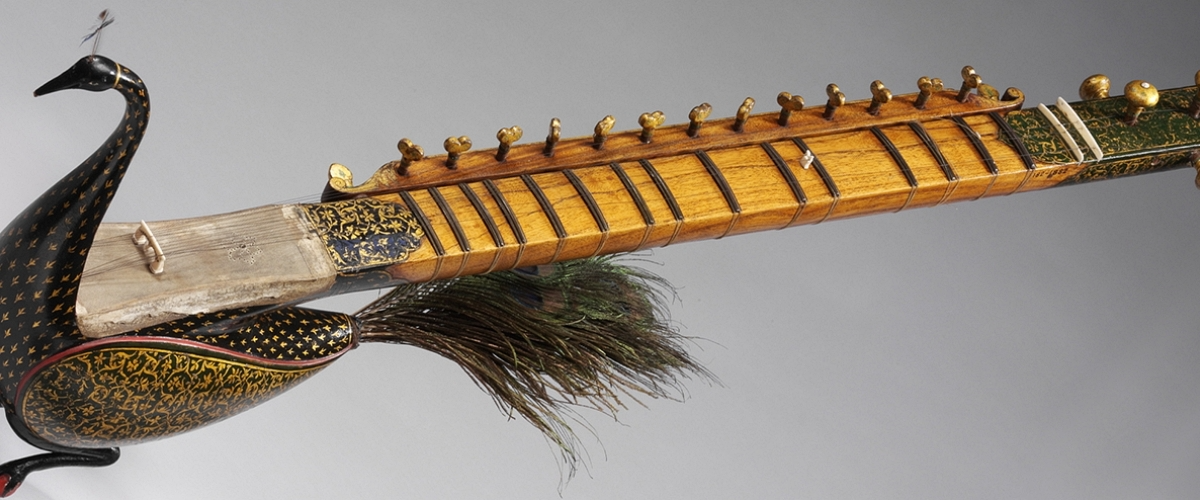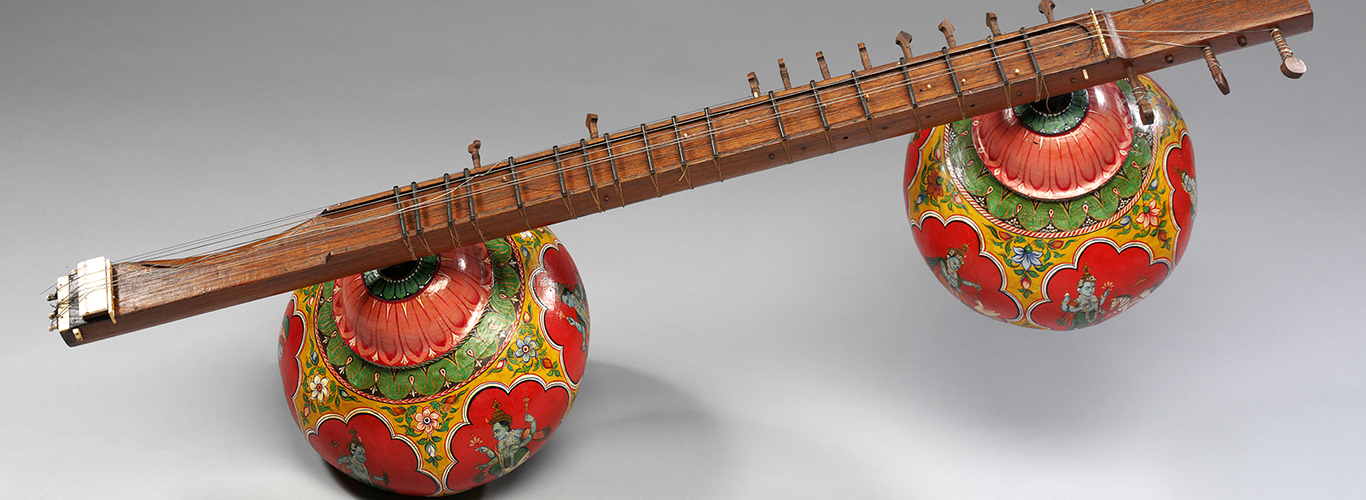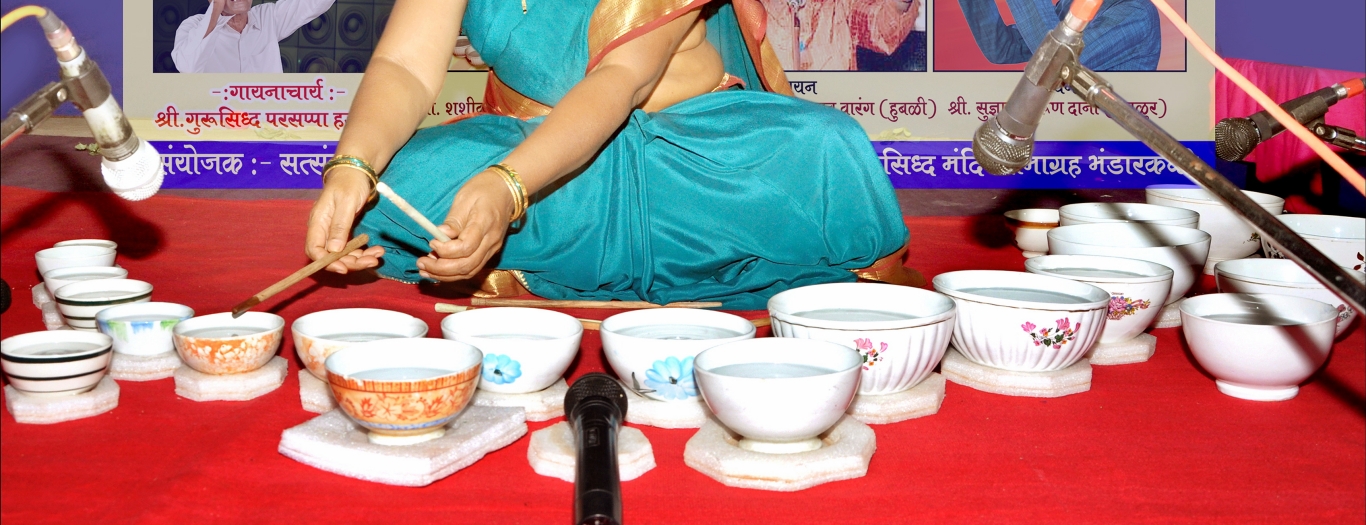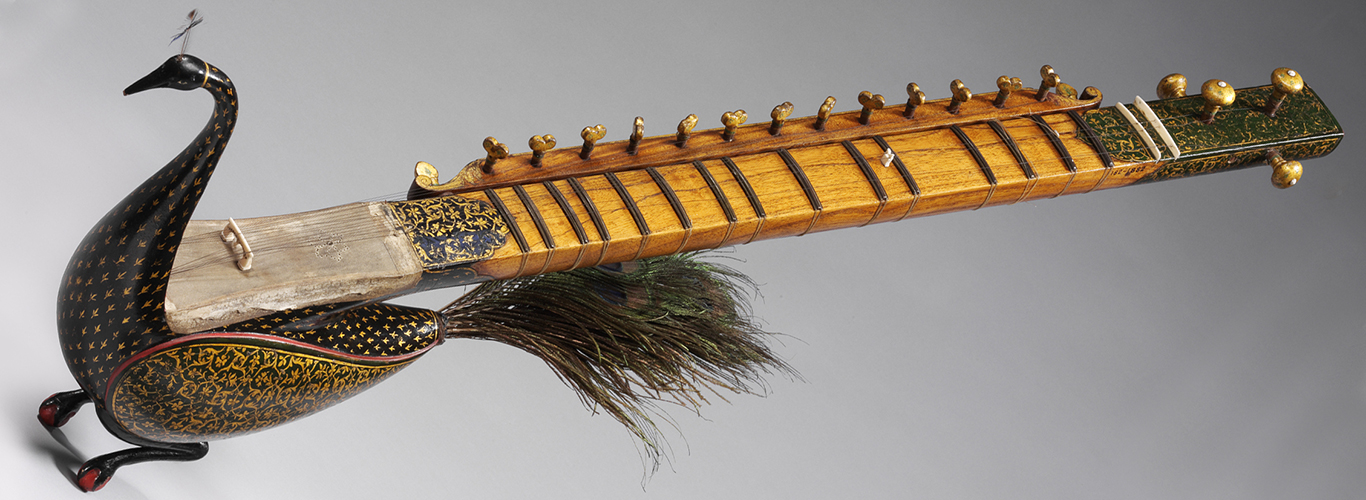

Exploring the sounds, origins, and modern contexts of ten strange, beautiful instruments from India's classical traditions.
—Part of Living Traditions: 21 articles for 21st-century Indian classical music
Indian classical music is renowned for its rich, distinctive sonorities. Musicians play over heavy drones and quivering, ambiguous rhythms, as much exploring the textures of their instrument as the notes of the raga. They emulate and extend the expressive flexibility of the human voice, seeking to capture gayaki ang (singing style).
All music is a study in sound itself, but Indian instruments often have a particular power to immediately entrance. The sound of Pandit Ravi Shankar’s sitar being tuned was enough to evoke warm applause from the audience at the 1971 Concert for Bangladesh, who assumed it to be the actual performance (“If you appreciate the tuning so much, I hope you will enjoy the playing more…”).
Creations come in all shapes and sizes, from the huge surbahar (bass sitar) to the pocket-sized morsing (jaw harp). Some are ancient, like the mridangam (frame drum), while others are modern adaptations, such as the Mohan veena (Indo-Hawaiian slide guitar). Origin stories can point to specific times and places, such as Pandit Debashish Bhattacharya’s creation of the anandi (slide ukulele) in 2002, or fade into myth - Lord Krishna is said to have invented the bansuri (bamboo flute) to aid in his seduction of the Gopi milkmaids.
This article explores the sounds and contexts of ten curious musical creations from across Indian classical music. Go through in order, or jump to one of the rudra veena, surbahar, taus, sitar been, chaturangi, sarangi, tabla tarang, jaltarang, ghatam, and morsing.
Though rare nowadays, many still see the rudra veena as the king of Indian instruments. The tone is even, measured, and austere, harking back to a more patient age where musicians played longer and slower. Few learn it today, but it continues to be linked with a certain universal purity, close to the essence of Indian classical.
It is an odd marriage of shapes. Two dark resonator gourds extend backwards, while 22 knife-like frets are arranged along a flat, two-dimensional plane. Musicians can play vertically, moving up and down the strings, or horizontally, bending across a single fret. Similar instruments include the Sagar veena, Saraswati veena, and Vichitra veena (‘curious veena’), although it is unclear if all supposed members of this family even share a common ancestor.
Traditionally associated with Lord Shiva, the name translates to ‘roaring veena’, suggesting an incarnation of the deity. It is at home in sacred settings, historically being used to accompany Vedic mantra-pathan (prayer recitals) and yajna (fire rituals). For many it was a path to ascetic self-knowledge - D.R. 'Veena Baba' Parvatikar lived his life as a monk in the Himalayas, bringing dhrupad music to worshippers at the Badrinath Temple and eventually gaining recognition as a Hindu saint.
The late 19th century saw its reserved tones supplanted by the louder surbahar (featured below). But musicians responded - Ustad Asad Ali Khan refined the khandarbani style, and Ustad Zia Mohiuddin Dagar modified his veena’s design, incorporating larger gourds, thicker strings, and a broader neck. The deeper sonorities gave new life to the instrument, allowing for extended explorations of mandra saptak (low octave).
But harder times were soon ahead. Indian independence saw the demise of the princely court system, removing dhrupad’s traditional setting. The Dagar family struggled for almost three decades, making bread, working in garages, and eventually having to sell their instruments. But they continued to sing and play, and eventually achieved a partial resurrection for the Dagarvani dhrupad.
The Dagar family helped facilitate rudra veena festivals in 2010 and 2017, and Zia’s son Ustad Bahauddin Dagar tours the world today, recently playing a landmark solo concert at London’s Purcell Room (read my interview with Bahauddin about it here). But old-style gurus are now few and far between, and master craftspeople rarely focus on older veena designs - a single specimen takes around eight months to build.
The rudra veena may be facing an existential crisis in India, but recent years have seen a growth in dedicated Western learners. Leading global exponents now include Carsten Wickie, a German, and Heikel Ben Mlouka, a French-Tunisian. Other barriers are falling too - in recent years Jyoti Hegde has emerged as the first successful female performer.
• Raag Lalit | Jyoti Hegde
• Raag Patdeep | Ustad Bahauddin Dagar
• Learning India’s king instrument as a woman | Jyoti Hegde interview
The surbahar is much more than just a bass sitar. Its deep-toned strings can bend upwards over an octave, allowing artists to explore the contours of a raga using only a single fret. Suited to the slow elaborations of dhrupad, it is large, heavy, and notoriously difficult to play.
Western bassists are (often unfairly) the butt of jokes. But this trend is reversed in Indian classical music, with virtually all seeing the surbahar as harder to master than the sitar. Raga performance is a test of strength and stamina as well as musicality - performers must intone precisely while holding up the sheer weight of the instrument for hours at a time.
Made from tropical hardwoods such as teak, the head is typically ornamented with the head of a bird or snake. Though originally adapted from proto-sitars such as the kachapi veena, the playing style has always remained closer to been baaj, the slower repertoire of the rudra veena. The name translates to ‘springtime of musical notes’.
It gained popularity in the mid-19th century, bridging the veena’s decline with the advent of the sitar. But the early 20th century saw it struggle to find a place in the dominant khayal style, stranded far below the vocal register. The sitar’s design continued to be improved over time too, with the Imdadkhani gharana thickening the sound and extending the low end.
For a while it was common for musicians to play a raga’s rhythmless alap introduction on the surbahar, then switch to the sitar for the gat (main melodic theme). But the sitar soon took over the concert hall, and today the instrument is comparatively rare.
2018 saw the passing of two old greats: Imrat Khan, younger brother of Vilayat, and the late virtuoso Annapurna Devi, daughter of Ustad Alauddin Khan, who trained her alongside her brother Ustad Ali Akbar Khan and future husband Pandit Ravi Shankar. Devi retired from public performance many decades ago, instead focusing on her own riyaz (immersive practice) and taking a few select students in her home.
She left tantalisingly few recordings, but the surbahar’s deep glides are audible in how ;her students approach their instruments, including Pandit Hariprasad Chaurasia's bansuri and Pandit Nikhil Banerjee's sitar. She might be the greatest musician we’ve never really heard.
Though less common nowadays, the surbahar has never really fallen into genuine obscurity. Musicians such as Irshad Khan, Pandit Budhaditya Mukherjee and Pandit Kushal Das play on into the 21st century, and modern sitarists continue to learn the instrument. Many feel they must uphold it, or else the music of the past will drift further from reach.
• Raag Jog | Pandit Kushal Das
• Raag Jhinjhoti | Pandit Budhaditya Mukherjee
• History of the surbahar | Pandit Kushal Das
The taus, or mayuri veena, is defined by shape as well as sound. The names translate from Farsi and Sanskrit to ‘peacock’, the national bird of India. Another curious veena family hybrid, it combines a sitar’s moveable frets with feathers and ornate paintwork.
It may seem to be as much sculpture as instrument, but the sound is unique. Played with a sarangi-like bow, it produces a clear, unadorned tone, impressively similar to the cry of the peacock (have a listen). Its inventor is reputed to have been either Guru Hargobind or Guru Gobind Singh, both 17th century Sikh warrior-saints.
Its heyday has long passed. Over the early 20th century it was largely replaced by the dilruba and esraj, its sturdier and more compact descendents. But the taus has enjoyed something of a resurgence in recent decades, as Sikh communities re-embrace Gurmat Sangeet (devotional music). A rare live recording of the instrument was made by Darbar Festival in 2015, showcasing Sandeep Singh’s sliding interpretation of Raag Ahir Bhairav.
• Creation myths of the taus | Bhai Baldeep Singh
• Raag Ahir Bhairav | Sandeep Singh
• Wonders of India: The Taus | Darbar Festival

Darbar restored this 19th century sitar been in 2015. Photo: V&A Museum
The sitar been is a near-extinct hybrid from the Pune region. Its double gourds are often decorated with incarnations of Vishnu, and the neck is hollow, meaning the whole instrument resonates with the sound of each note.
It resembles a rudra veena as much as a sitar namesake, with flat frets, two resonators, and a similar tuning. But like a sitar, the frets are moveable, allowing direct access to the full range of sruti (microtones).
The quiet tone is said to be suited to slow movement, but it is unclear if the instrument was ever recorded until Darbar Festival’s Musical Wonders of India project restored the sitar been pictured above. It was repaired after a century of disuse, enabling dhrupad maestro Ustad Bahauddin Dagar to bring its sound to the present day for a one-off 2015 concert.
Pandit Debashish Bhattacharya built his first slide guitar at the age of 15. He has since created a collection of them, and now tours the world with his ‘Guitar Trinity’ - the 4-string anandi, the 14-string gandharvi, and the 23-string chaturangui. He describes the latter as a blend of sitar, violin, sarod, and rudra veena.
Bhattacharya was not the first Hindustani classical slide guitarist. In his youth he studied with Pandit Brij Bhushan Kabra, famous for playing the instrument on the landmark 1967 album Call of the Valley. Other musicians have come up with their own eponymous variants too, including the Mohan veena, Hansaveena and Shankar veena.
But the chaturangi is not an adapted Western guitar - Bhattacharya designed it from scratch, giving it a stronger resonance than any of its competitors. He has since taken the art of slide to unprecedented realms - the short scale length allows for unique glides and vibratos, and the crisp vocal-register tone is ideal for evoking Hindustani music's intricate 'singing' ornaments and melodic turns. It can play chords too - a rare capability in the melodically-driven world of Indian classical.
Bhattacharya draws inspiration from Hawaiian lap-slide styles as well as the sitar. But he is cautious not to dilute the core elements of Hindustani music, telling me in an interview that “it’s about creating new wings, not polluting”. For now the chaturangi remains unchallenged as the king of Hindustani slide, but this may not last - Bhattacharya mentioned that he has three more creations on the way.
• Raag Shuddh Sarang | Pandit Debashish Bhattacharya
• Kirwani improvisation | Pandit Debashish Bhattacharya
• NPR Tiny Desk Concert | Pandit Debashish Bhattacharya & family
The sarangi is sometimes described as the ‘Indian violin’. But while both are bowed, fretless instruments, it sounds little like its Western counterpart. Performers fret the underside of the strings with the tops of their fingers, sliding to blur the boundaries of a melody. They ‘speak inside’, aiming to convey the syllables of the composition in their playing.
It has a brightly resonant, almost horn-like tone, thickened with an array of up to 37 sympathetic strings. Thought to have evolved from Rajasthani folk instruments, the modern sarangi is carved from a single block of red cedar wood. Its three resonating chambers are named after parts of the body - pet (stomach), chhaati (chest), and magaj (brain). The word sarangi translates to ‘one hundred colours’, said to reflect its expressive range.
It occupies a strange place in the classical pantheon - renowned as one of the hardest and most versatile instruments, but lacking in status and popularity. It is often considered to be the most adept of all instruments at capturing the nuances of vocal music, and has consequently been used to accompany singers for centuries. But this strength has served to hold it down - in India, as in the West, few pay enough attention to the supporting cast.
It gained greater acceptance as a lead instrument in the 20th century, thanks to the efforts of musicians such as Pandit Ram Narayan, Ustad Sultan Khan, and Ustad Abdul Latif Khan. The modern repertoire is firmly rooted in vocal forms such as khayal and thumri, and many esteemed male singers of the era came from sarangi-playing families, including Ustad Bade Ghulam Ali Khan, Ustad Amir Khan, and Pandits Rajan & Sajan Mishra.
But the advent of the easier and cheaper harmonium has gradually eroded the sarangi’s status. Many lament this trend - the harmonium cannot slur notes like a singer, and cannot access sruti (microtones), essential to Indian music’s gayaki ang (singing style). Modern sarangist Nicolas Magriel derides it as “a European instrument that, to my ears, injects the ethos of fairground brashness to what was once a peaceful, subtle and glorious musical system”.
But the sarangi is not truly endangered yet. Singers continue to hold it in high regard, saying that sarangists have an unparalleled understanding of the vocalist’s mind. Most tabla soloists ideally prefer to play over a sarangi lehra (looped melody), and the instrument is still in demand as a top-level solo leader.
• Raag Shree | Kamal Sabri
• Raag Mishra Gara | Pandit Bharat Bhushan Goswami
• Origins of the Sarangi | Kamal Sabri interview
• Sangi Rangi | Nicolas Magriel’s sarangi archive
If you constantly thirst for more tabla then why not listen to Pandit Kamalesh Maitra play 13 of them at once? The tabla tarang is a semicircle of dayan (right-hand) drums tuned to the notes of the raga. And if this still isn’t enough then how about adding Trilok Gurtu’s ‘standard’ tabla to accompany him?
Percussionists always seek to surround themselves with rhythm. Western drummers never seem to know when to stop adding new toys - Terry Bozzio’s drumset obscures him from view, and Mark Temperato’s 340-piece kit features the world’s largest gong.
The tabla tarang (‘wave of tabla’) may look similarly excessive. but it is not - Indian music is economical and precise, and the tarang wastes nothing. Unnecessary movement must be minimised to navigate a raga’s wide jumps, and each drum is tuned uniquely.
Performers rotate vast distances to catch each interval, mimicking the dexterity of many-armed gods. The layout of the instrument lends itself towards sparse playing, in contrast to standard tabla’s dense patter. Live performance is a uniquely physical experience - few instruments can push sound in so many different directions.
Maitra was the instrument’s last great master. His melodies on Raag Deen Todi have an angular gait, but the strokes which make them up are muted, with rounded edges. It is an unforgiving sound, austere even in aggression, providing a relief from the shimmer and glide of other classical instruments. It’s almost like hearing Hindustani music in black-and-white.
The tabla tarang is less a rare instrument, more a rare arrangement of a common instrument. But while tabla drums may be found in households across India, the tarang is a precise grouping of them. Mastery takes years, and opportunities to perform are limited. Maitra passed away in 2005, and few focus on the instrument today. Hindustani music is weaker for it - honing in on the tabla’s melodic aspects helps deepen our appreciation for it in any context.
• Raag Deen Todi | Kamalesh Maitra & Trilok Gurtu
• Raag Bilaskhani Todi | Kamalesh Maitra & Trilok Gurtu
• Raag Bhupali | Pandit Ram Krishna Bose

Do you sip to tune them?
Jaltarang, another melodic percussion instrument, translates literally as ‘waves in water’. Bone china bowls are precisely filled and struck with bamboo sticks, producing a sharp, ringing tone. Though visually reminiscent of the tabla tarang, it sounds nothing like it.
It is an ancient instrument, with variants turning up in many cultures. It once had its own corner of Hindustani music, with Shashikala Dani and Ranjana Pradhan performing dexterously on All India Radio for decades. But despite its simplicity, few play it today.
The timbre is quiet, and there are no ‘spaces between the notes’, rendering meend (glides) and other essential techniques impossible. The design is somewhat impractical, requiring it to be tuned from scratch for each performance. But the jaltarang is cheap and comparatively straightforward. No instrument that resembles a childhood kitchen experiment will ever really die off.
• Raag Multani | Shashikala Dani
• Raag Kalavati | Ranjana Pradhan
• Raag Puriya Dhanashree | Milind Tulankar
Essentially just a earthenware pot, the ghatam is used throughout South India. Equally at home in folk or classical contexts, it is commonly paired with the tabla-like mridangam to accompany Carnatic vocalists and violinists. But can hold centre-stage in its own right too, thudding out rapid-fire lines as part of a raga’s Tani Avartanam (extended percussion section).
The instrument is fashioned from clay, sometimes mixed with brass or gold filings mixed for a sharper tone. It is roughly spherical, with a small opening to release the sound. Simplicity is no barrier to variety - musicians use their nails, fingers, palms, wrists, and elbows to summon a dazzling array of sounds.
The main tones all have a sharp metallic crack. But this initial punch quickly fades away, leaving a brief overtone-rich echo. Fast sequences are a rain-like patter, full of flourish and ambiguous resolution. Drummers flick, tap, and slap, and go low too - they can strike the opening with a flat hand to produce gumki, a deep, airy bass, which can be raised in pitch by squeezing the pot towards themselves.
The ghatam is said to represent the pancha mahabhuta - the five great elements of Hinduism. It is made of earth (bhumi), designed to hold water (jala), hardened in a kiln’s fire (agni), filled with empty space (akash), and produces sound with moving air (vayu). Similar instruments have been around for millennia, visible in stone carvings and described in Sanskrit musicological treatises such as the Natya Shastra.
Unlike many of the instruments mentioned here, the ghatam is alive and well today. It has gone global thanks in part to the efforts of T. H. ‘Vikku’ Vinayakram and his son Selvaganesh, who toured the world as part of John McLaughlin’s Shakti and Remember Shakti groups. The clay pot continues to thrive.
• Live at Afghan Church | Vikku Vinayakram & TM Krishna
• Intense Tani Avartanam | Dr. Trichy Sankaran & Giridhar Udupa
• Everybody Has Rhythm Inside Us | Giridhar Udupa interview
The jaw harp is found on all the earth’s inhabited continents, with scholars estimating that there are over a thousand distinct names for it. Like the instrument itself, many have a pleasing syllabic ring to them - the Indian morsing, Indonesian genggong, Nepalese murchunga, Persian zanboorak, Norwegian munnharpe, Finnish huuliharppu, Tuvan khomus, Lithuanian dambrelis, and Italian marranzano (let’s leave aside the German maultrommel).
Abraham Lincoln is said to have played one to mock his opponent’s brass band at a town-hall debate, and rumours circulate that Stalin banned it as a symbol of shamanism. Johann Georg Albrechtsberger, Beethoven’s principal teacher, wrote seven curious concerti for jaw harp and orchestra, and 19th century Austrian society later grew to fear the instrument’s corrupting influence.
Musicologist Anthony Baines describes its devious reputation: “So popular was the custom and so discreet and persuasive the sound of the guimbarde...that female virtue was endangered and instruments were repeatedly banned by the authorities”.
So we shouldn’t underestimate it. Though small, the timbre is immediately powerful, somewhere between a drone and a drum. It has a warm shiver, a weightlessness, a syllabic roll, speaking as much as singing. The frequencies it summons bring out the harmonic series, the mathematically fundamental notes of the universe.
Traditionally made of iron, the morsing works on the same principles as all other jaw harps. A metal ‘tongue’ is plucked with the fingers, transferring vibration to the player’s head via the front teeth. The skull becomes the amplifier, and some use the sensation to aid with their pranayama breathing meditation.
Changing the shape of the mouth cavity alters which frequencies are most prominent, as if moving between vowel sounds rather than notes (some theatrical traditions use the jaw harp to embellish actual conversation). You cannot shift the pitch without refitting the instrument - to lower it, beeswax is applied to the tongue’s plucking end.
It is widely used in Carnatic classical contexts, often mirroring the lead lines of the mridangam. Top-level ghatam players are often morsingists too, switching between instruments as a performance progresses. Rajasthani lok geet folk musicians use it, and groups such as Shakti have immortalised it in fusion settings. The instrument is simple, cheap, and versatile, and will continue to thrive.
• Carnatic morsing solo | N Sundar
• Nepalese murchunga solo | Shyam Sharan
• Morsing quartet | Morsing Bhimachar & family
• George Howlett is a London-based musician and writer, specialising in jazz, rhythm, Indian classical, and global improvised music.

Darbar believes in the power of Indian classical music to stir, thrill, and inspire. Explore our YouTube channel, or subscribe to the Darbar Concert Hall to watch extended festival performances, talk and documentaries in pristine HD and UHD quality.
The santoor's icy sparkle is a comparative newcomer to Indian classical music. Here's a seven-part primer on this...
Read More 
In the centuries-old tradition of Indian classical music, few living legends can claim to have single-handedly made...
Read More 
The Gwalior khayal star discusses religious tolerance, changing teaching styles, and her recent book. By George...
Read More 
The beginner's guide to Indian classical music. Whether you’re completely new to raga music or just need a refresher, we’ve put together this brief overview of all things raga music to help you feel at ease when visiting one of our concerts or watch our videos on our YouTube or our Darbar Concert Hall.
Keep up to date with the latest news, events, music and musings across our social channels
For hundreds more clips and shorts, vist our YT page here 